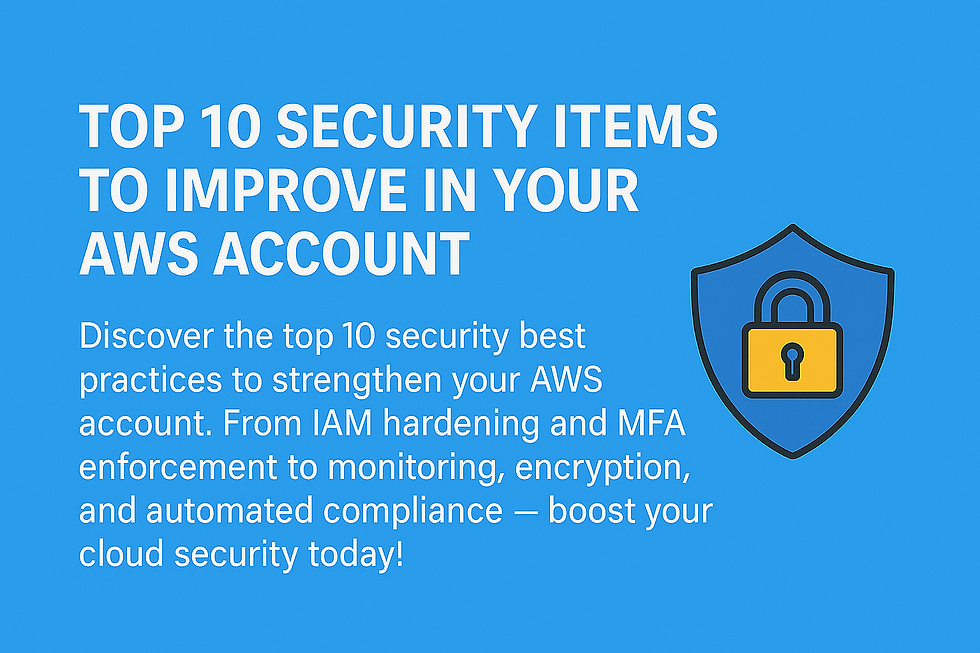Top 10 Security Items to Improve in Your AWS Account
- 5 days ago
- 4 min read
By Ananta Cloud Engineering Team | Security | September 27, 2025

Security in AWS is a shared responsibility between AWS and you—the customer. While AWS secures the infrastructure, you're responsible for securing your workloads, configurations, and data. At Ananta Cloud, we help organizations harden their cloud environments by identifying and resolving security blind spots before they become vulnerabilities.
In this blog, we’ll explore the Top 10 security items you can (and should) improve in your AWS account today to reduce risk, increase visibility, and align with cloud security best practices.

01. Enable and Configure AWS CloudTrail Across All Regions
Why it matters: CloudTrail provides a record of all API activity in your AWS account. Without it, you're effectively blind to unauthorized or suspicious activity.
How to improve:
Ensure CloudTrail is enabled in all regions, not just the default.
Create a multi-region trail and send logs to a centralized, encrypted S3 bucket.
Enable log file validation and integrate with CloudWatch Logs or SIEM tools for alerting.
Use AWS Config and Security Hub to flag accounts missing CloudTrail.
02. Enforce Multi-Factor Authentication (MFA) for All IAM Users and Root
Why it matters: Passwords alone are not secure. MFA prevents unauthorized access even if credentials are compromised.
How to improve:
Enable MFA on the root user (ideally, don’t use root at all).
Require MFA for all IAM users, especially those with console or programmatic access.
Use IAM policies or AWS Config rules to detect users without MFA.
Bonus: Move toward using federated access (e.g., SSO) and eliminate IAM users where possible.
03. Use IAM Roles and Avoid Long-Lived Credentials
Why it matters: Hard-coded access keys can be easily compromised. Roles allow for temporary credentials that rotate automatically.
How to improve:
Replace IAM users with IAM roles for both human and machine identities.
Use EC2 instance roles, Lambda execution roles, and ECS task roles appropriately.
Monitor and remove any unused or long-standing access keys.
Rotate credentials every 90 days or less if keys are absolutely necessary.
04. Enable GuardDuty for Threat Detection
Why it matters: AWS GuardDuty is a powerful threat detection service that continuously monitors for malicious or unauthorized behavior.
How to improve:
Enable GuardDuty in all regions.
Integrate with Security Hub for centralized findings.
Set up automated remediation workflows using EventBridge + Lambda.
Watch out for crypto mining, IAM anomaly detection, and suspicious DNS requests.
05. Harden S3 Buckets – No Public Access Unless Explicitly Required
Why it matters: Misconfigured S3 buckets remain one of the most common causes of data leaks in AWS.
How to improve:
Enable S3 Block Public Access (BPA) at the account and bucket level.
Use bucket policies and IAM policies to tightly control access.
Turn on S3 server-side encryption and access logging.
Periodically scan with Macie or third-party tools.
Run regular audits for any buckets with public permissions using AWS Config or Trusted Advisor.
06. Enforce Least Privilege with IAM Policies
Why it matters: Over-permissioned IAM roles and users are a ticking time bomb for lateral movement in your environment.
How to improve:
Use IAM Access Analyzer to detect unused permissions.
Define fine-grained policies, avoiding * in Action or Resource unless absolutely required.
Tag and document roles for better auditing and lifecycle management.
Create CI/CD pipelines for IAM policy updates and reviews.
07. Use AWS Config to Monitor Resource Compliance
Why it matters: AWS Config tracks configuration changes and helps enforce compliance across your account.
How to improve:
Enable AWS Config globally.
Create custom Config rules or use managed rules for:
Unencrypted EBS volumes
Open security groups
Root account usage
Integrate findings into AWS Security Hub for a single pane of glass.
Use Config to generate periodic compliance reports for audits.
08. Restrict and Monitor Security Groups and Network ACLs
Why it matters: Overly permissive network access (e.g., open ports to the world) is a serious vulnerability.
How to improve:
Disallow 0.0.0.0/0 for SSH (port 22) and RDP (port 3389) unless through a bastion or VPN.
Use network segmentation via VPCs, subnets, and security groups.
Monitor changes using VPC Flow Logs and Config rules.
Automate remediation of non-compliant rules with Lambda functions.
09. Encrypt Data at Rest and in Transit
Why it matters: Encryption protects your data from unauthorized access even if it’s exfiltrated.
How to improve:
Enable encryption by default for S3, EBS, RDS, Redshift, and DynamoDB.
Use AWS KMS with CMKs (Customer Managed Keys) for greater control.
Enforce TLS 1.2+ for all endpoints and client communications.
Audit encryption compliance using AWS Config and Security Hub.
10. Centralize Security Operations and Logging
Why it matters: Disparate logs and alerts reduce your ability to respond quickly and effectively to incidents.
How to improve:
Centralize logs in an organization-wide logging account.
Use CloudWatch Logs, S3, and Kinesis Firehose to ingest data.
Integrate with a SIEM or use Amazon OpenSearch Service for log analytics.
Set up AWS Security Hub and Organizations for centralized security findings.
Final Thought
Security in AWS isn’t a one-time task—it’s a continuous journey. The ten improvements outlined above are critical building blocks of a strong cloud security posture. Whether you’re running a single-account environment or a complex AWS Organization, Ananta Cloud helps you identify gaps, enforce best practices, and scale securely.
Need help with a security assessment or automation playbooks?
Get in touch with the Ananta Cloud team to schedule a free consultation or sign up for our AWS security audit toolkit.
Let’s Secure Your AWS – Together
Email: hello@anantacloud.com | LinkedIn: @anantacloud | Schedule Meeting




Comments